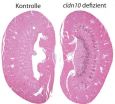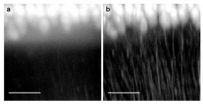(Press-News.org) Sodium chloride, better known as salt, is vital for the organism, and the kidneys play a crucial role in the regulation of sodium balance. However, the underlying mechanisms of sodium balance are not yet completely understood. Researchers of the Max Delbrück Center for Molecular Medicine (MDC) Berlin-Buch, Charité – Universitätsmedizin Berlin and the University of Kiel have now deciphered the function of a gene in the kidney and have thus gained new insights into this complex regulation process (PNAS Early Edition, doi/10.1073/pnas.1203834109)*.
In humans, the kidneys filter around 1700 liters of blood every day, of which 180 liters are collected as primary urine and ultimately one to two liters of urine are excreted. The kidneys thus wash toxic waste products out of the body, but retain some useful substances and reintroduce them into the body, thus simultaneously regulating the salt and water balance.
Molecular velcro
In the study just published by Dr. Tilman Breiderhoff, Prof. Thomas Willnow (both MDC), as well as Dr. Nina Himmerkus and Prof. Markus Bleich (both of the University of Kiel) and Dr. Dominik Müller (Charité) the focus is on the claudin-10 gene, which is expressed in a specific segment of the kidney, in Henle's loop. In the thick ascending limb of this loop, , a large part of the filtered sodium chloride, as well as calcium and magnesium are reabsorbed. The gene product under investigation, the claudin 10 protein, belongs to a family of proteins that connect the epithelial cells which cover the inner and outer surfaces of the body and stick them together like velcro. Claudins, however, also form pores, through which ions and substances are transported between the cells.
"If these transport processes are disturbed, this can lead to serious loss of function of the kidneys," Dr. Breiderhoff explained. As example he cited various human hereditary diseases in which either absorption of table salt (Bartter syndrome) or of calcium and magnesium (familial hypomagnesemia with hypercalciuria and nephrocalcinosis – FHHNC) is disturbed. The second disease is characterized by a lack of magnesium in the blood and an excess of calcium in the urine, which leads to calcification of the kidneys. It is caused by mutations in one of two genes (claudin 16 or claudin 19), which also belong to the gene family of the claudins.
The researchers have now demonstrated in mice that the claudin-10 gene is involved in the reabsorption of salt in the kidney. If the gene in the kidney is deactivated, the reabsorption of sodium is impaired, but the reabsorption of calcium and magnesium is increased. The consequence is that the mice have elevated magnesium levels in the blood, and excess calcium is deposited in the kidney. Simultaneously, the urine volume is increased because the kidneys of the mice cannot reabsorb enough water, a sign that the recovery of salt is disturbed.
INFORMATION:
*Deletion of Cldn10 in the thick ascending limb impairs paracellular sodium permeability and leads to hypermagnesemia and nephrocalcinosis
Tilman Breiderhoffa,1, Nina Himmerkusb, Marchel Stuiverc, Kerim Mutigd, Constanze Willc, Iwan C. Meija, Sebastian Bachmannc, Markus Bleichb, Thomas E. Willnowa, and Dominik Müllerd,1
aMax Delbrück Center for Molecular Medicine, 13125 Berlin, Germany; bInstitute of Physiology, Christian Albrechts University of Kiel, 24098 Kiel, Germany; cDepartment of Pediatric Nephrology, Charité Universitätsmedizin, 13353 Berlin, Germany; and dInstitute for Vegetative Anatomy, Charité Universitätsmedizin, 10117 Berlin, Germany
A photo can be downloaded from the Internet at:
http://www.mdc-berlin.de/en/index.html
PHYSIOLOGY
Contact:
Barbara Bachtler
Press Department
Max Delbrück Center for Molecular Medicine (MDC) Berlin-Buch
in the Helmholtz Association
Robert-Rössle-Straße 10
13125 Berlin, Germany
Phone: +49 (0) 30 94 06 - 38 96
Fax: +49 (0) 30 94 06 - 38 33
e-mail: presse@mdc-berlin.de
http://www.mdc-berlin.de/
New insights into salt transport in the kidney
2012-08-23
ELSE PRESS RELEASES FROM THIS DATE:
Cloud control could tame hurricanes, study shows
2012-08-23
They are one of the most destructive forces of nature on Earth, but now environmental scientists are working to tame the hurricane. In a paper, published in Atmospheric Science Letters, the authors propose using cloud seeding to decrease sea surface temperatures where hurricanes form. Theoretically, the team claims the technique could reduce hurricane intensity by a category.
The team focused on the relationship between sea surface temperature and the energy associated with the destructive potential of hurricanes. Rather than seeding storm clouds or hurricanes directly, ...
Canadian researcher is on a mission to create an equal playing field at the Paralympic Games
2012-08-23
Vancouver, BC – August 23, 2012 – Vancouver-based clinician and researcher Dr. Andrei Krassioukov is packing for the upcoming Paralympic games in London. Rather than packing sports equipment, he has a suitcase full of advanced scientific equipment funded by the Canada Foundation for Innovation that he will use to monitor the cardiovascular function of athletes with spinal cord injuries.
Up to 90% of people with injuries between that cervical and high thoracic vertebrae suffer from a condition that limits their ability to regulate heart rate and blood pressure. For top-level ...
Scientists produce H2 for fuel cells using an inexpensive catalyst under real-world conditions
2012-08-23
Scientists at the University of Cambridge have produced hydrogen, H2, a renewable energy source, from water using an inexpensive catalyst under industrially relevant conditions (using pH neutral water, surrounded by atmospheric oxygen, O2, and at room temperature).
Lead author of the research, Dr Erwin Reisner, an EPSRC research fellow and head of the Christian Doppler Laboratory at the University of Cambridge, said: "A H2 evolution catalyst which is active under elevated O2 levels is crucial if we are to develop an industrial water splitting process - a chemical reaction ...
1-molecule-thick material has big advantages
2012-08-23
CAMBRIDGE, MA -- The discovery of graphene, a material just one atom thick and possessing exceptional strength and other novel properties, started an avalanche of research around its use for everything from electronics to optics to structural materials. But new research suggests that was just the beginning: A whole family of two-dimensional materials may open up even broader possibilities for applications that could change many aspects of modern life.
The latest "new" material, molybdenum disulfide (MoS2) — which has actually been used for decades, but not in its 2-D ...
Is this real or just fantasy? ONR Augmented-Reality Initiative progresses
2012-08-23
ARLINGTON, Va.—The Office of Naval Research (ONR) is demonstrating the next phase of an augmented-reality project Aug. 23 in Princeton, N.J., that will change the way warfighters view operational environments—literally.
ONR has completed the first year of a multi-year augmented-reality effort, developing a system that allow trainees to view simulated images superimposed on real-world landscapes. One example of augmented reality technology can be seen in sports broadcasts, which use it to highlight first-down lines on football fields and animate hockey pucks to help TV ...
Spacetime: A smoother brew than we knew
2012-08-23
Spacetime may be less like beer and more like sipping whiskey.
Or so an intergalactic photo finish may suggest.
Physicist Robert Nemiroff of Michigan Technological University reached this heady conclusion after studying the tracings of three photons of differing wavelengths that were recorded by NASA's Fermi Gamma-ray Space Telescope in May 2009.
The photons originated about 7 billion light years away from Earth in one of three pulses from a gamma-ray burst. They arrived at the orbiting telescope just one millisecond apart, in a virtual tie.
Gamma-ray bursts are ...
Novel microscopy method offers sharper view of brain's neural network
2012-08-23
WASHINGTON, Aug. 23—Shortly after the Hubble Space Telescope went into orbit in 1990 it was discovered that the craft had blurred vision. Fortunately, Space Shuttle astronauts were able to remedy the problem a few years later with supplemental optics. Now, a team of Italian researchers has performed a similar sight-correcting feat for a microscope imaging technique designed to explore a universe seemingly as vast as Hubble's but at the opposite end of the size spectrum—the neural pathways of the brain.
"Our system combines the best feature of one microscopy technique—high-speed, ...
How to feed data-hungry mobile devices? Use more antennas
2012-08-23
Researchers from Rice University today unveiled a new multi-antenna technology that could help wireless providers keep pace with the voracious demands of data-hungry smartphones and tablets. The technology aims to dramatically increase network capacity by allowing cell towers to simultaneously beam signals to more than a dozen customers on the same frequency.
Details about the new technology, dubbed Argos, were presented today at the Association for Computing Machinery's MobiCom 2012 wireless research conference in Istanbul. Argos is under development by researchers from ...
Vanderbilt-led study reveals racial disparities in prostate cancer care
2012-08-23
A study led by investigators from Vanderbilt-Ingram Cancer Center (VICC), Nashville, Tenn., finds that black men with prostate cancer receive lower quality surgical care than white men. The racial differences persist even when controlling for factors such as the year of surgery, age, comorbidities and insurance status.
Daniel Barocas, M.D., MPH, assistant professor of Urologic Surgery, is first author of the study published in the Aug. 17 issue of the Journal of Urology.
Investigators from VICC, the Tennessee Valley Veterans Administration Geriatric Research, Education ...
Sensor detects glucose in saliva and tears for diabetes testing
2012-08-23
WEST LAFAYETTE, Ind. – Researchers have created a new type of biosensor that can detect minute concentrations of glucose in saliva, tears and urine and might be manufactured at low cost because it does not require many processing steps to produce.
"It's an inherently non-invasive way to estimate glucose content in the body," said Jonathan Claussen, a former Purdue doctoral student and now a research scientist at the U.S. Naval Research Laboratory. "Because it can detect glucose in the saliva and tears, it's a platform that might eventually help to eliminate or reduce ...


